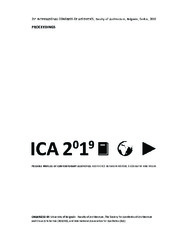Приказ основних података о документу
Mobilizing the Image: Ideological Narrative in The Interior Design of The Sava Center
| dc.creator | Kostić, Miloš | |
| dc.creator | Zorić, Ana | |
| dc.date.accessioned | 2023-11-15T20:40:30Z | |
| dc.date.available | 2023-11-15T20:40:30Z | |
| dc.date.issued | 2019 | |
| dc.identifier.isbn | 978-86-7924-224-2 | |
| dc.identifier.uri | https://raf.arh.bg.ac.rs/handle/123456789/1494 | |
| dc.description.abstract | The paper will examine the process of design and construction of the Sava conference center in Belgrade and its role in the creation of the ideological narrative on the disciplinary level through the conceptions of space. During the Cold war, Yu goslav cultural space was in a unique position between East and West, building its international image on the idea of political neutrality and the Non-aligned movement. The Sava center was built in 1977, for the purpose of hosting the second Conference on Security and Co-operation in Europe, and the Non-Aligned Movement in 1983. The building of the conference center was not only the functional necessity but was also an important factor in presenting Yugoslavia on the international lev el. By questioning the critical theory and the postmodern condition in the domain of representation of architecture, the main aim of the research is to trace the pos sible aspects of reading the aesthetic and symbolic layers within the interior de sign of Sava center. The main hypothesis is that that interior space was a crucial el ement in the creation of the continual simulacrum, which embodies the idea of political neutrality and self-managing socialism, presenting the Yugoslavian poli tics as diplomatic and open unlike its communist counterparts in the USSR. The Sava center is typically considered through the prism of political and econom ic aspects while neglecting the design approaches, images and conceptions of space. The idea of building the new center can be related to the postmodern un derstanding of losing imposed centrality in the vision of history and the dominance of the single image as a condition for the unquestionable way of interpretation. By analyzing primary sources stemming from the period of its construction and nu merous visual materials, the research aims to discover the possible influences and conditions by which the architectural approach to designing was determined. In general, it the awareness of the importance of critical examination of the social ist heritage in the modern context for the current understanding of the discipline. | sr |
| dc.language.iso | en | sr |
| dc.publisher | Belgrade : University of Belgrade, Faculty of Architecture | sr |
| dc.relation | info:eu-repo/grantAgreement/MESTD/Technological Development (TD or TR)/36034/RS// | sr |
| dc.rights | openAccess | sr |
| dc.source | Possible worlds of contemporary aesthetics: aesthetics between history, geography and media [Elektronski izvor] : proceedings / 21st International Congress of Aesthetics ICA 2019, Belgrade, 2019 ; organized by University of Belgrade, Faculty of Architecture [and] The Society for Aesthetics of Architecture and Visual Arts Serbia (DEAVUS), and International Association for Aesthetics (IAA) | sr |
| dc.subject | research paper | sr |
| dc.subject | Sava center | sr |
| dc.subject | socialist architecture | sr |
| dc.subject | postmodern condition | sr |
| dc.subject | ideology | sr |
| dc.subject | narrative | sr |
| dc.subject | heritage | sr |
| dc.subject | detail | sr |
| dc.subject | interior design | sr |
| dc.title | Mobilizing the Image: Ideological Narrative in The Interior Design of The Sava Center | sr |
| dc.type | conferenceObject | sr |
| dc.rights.license | ARR | sr |
| dc.citation.spage | 1915 | |
| dc.citation.epage | 1923 | |
| dc.identifier.fulltext | http://raf.arh.bg.ac.rs/bitstream/id/5152/bitstream_5152.pdf | |
| dc.identifier.rcub | https://hdl.handle.net/21.15107/rcub_raf_1494 | |
| dc.type.version | publishedVersion | sr |

